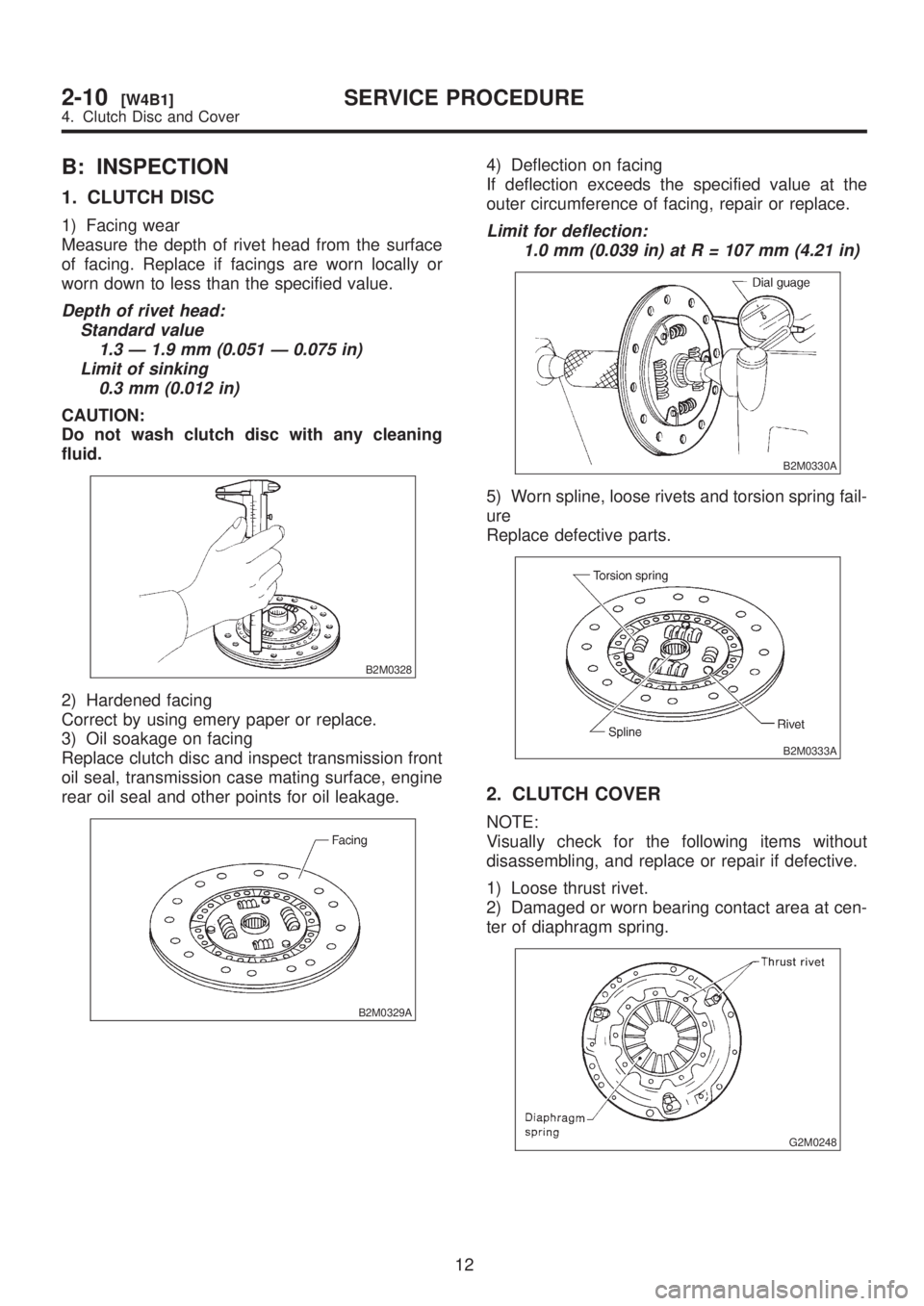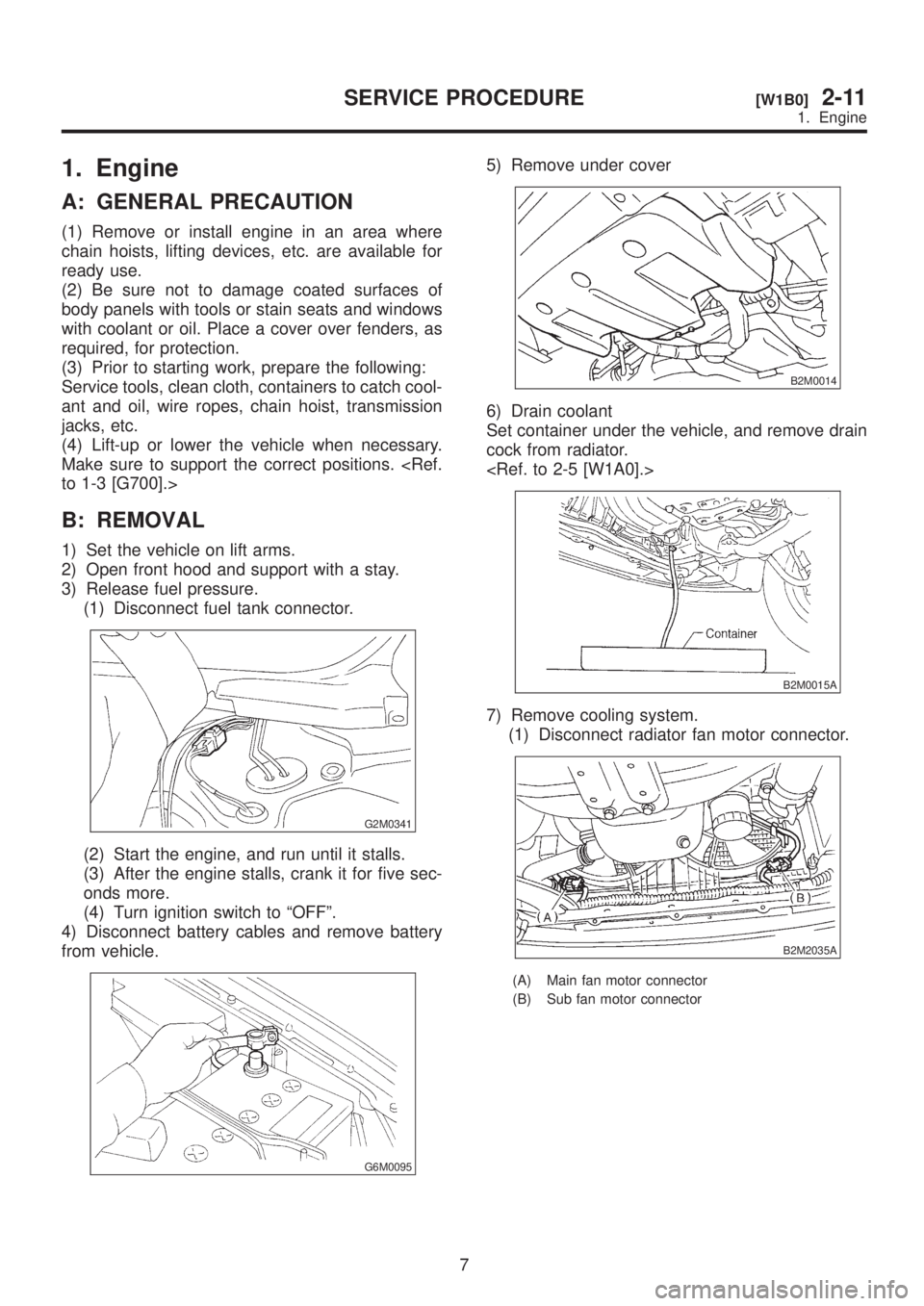Page 422 of 1456

2. HYDRAULIC APPLICATION TYPE
1) While pushing release lever to pivot and twist-
ing it to both sides, fit retainer spring onto the con-
stricted portion of pivot.
NOTE:
IApply grease (SUNLIGHT 2: P/N 003602010) to
contact point of release lever and operating cylin-
der.
IConfirm that retainer spring is securely fitted by
observing it through the main case hole.
2) Install release bearing and fasten it with two
clips.
3) Install release lever seal.
4) Install operating cylinder.
Tightening torque:
T: 3 7
±3 N´m (3.8±0.3 kg-m, 27.5±2.2 ft-lb)
B2M1257F
(A) Release lever
(B) Retainer spring
(C) Release bearing
(D) Clip
(E) Release lever seal
(F) Operating cylinder
5) After remounting engine and transmission on
body.
6) Bleed air from oil line with the help of a co-
worker.
4. Clutch Disc and Cover
A: REMOVAL
1) Install ST on flywheel.
ST 498497100C RANKSHAFT STOPPER
G2M0242
2) Remove clutch cover and clutch disc.
CAUTION:
ITake care not to allow oil on the clutch disc
facing.
IDo not disassemble either clutch cover or
clutch disc.
3) Remove flywheel.
G2M0243
11
[W4A0]2-10SERVICE PROCEDURE
4. Clutch Disc and Cover
Page 423 of 1456

B: INSPECTION
1. CLUTCH DISC
1) Facing wear
Measure the depth of rivet head from the surface
of facing. Replace if facings are worn locally or
worn down to less than the specified value.
Depth of rivet head:
Standard value
1.3 Ð 1.9 mm (0.051 Ð 0.075 in)
Limit of sinking
0.3 mm (0.012 in)
CAUTION:
Do not wash clutch disc with any cleaning
fluid.
B2M0328
2) Hardened facing
Correct by using emery paper or replace.
3) Oil soakage on facing
Replace clutch disc and inspect transmission front
oil seal, transmission case mating surface, engine
rear oil seal and other points for oil leakage.
B2M0329A
4) Deflection on facing
If deflection exceeds the specified value at the
outer circumference of facing, repair or replace.
Limit for deflection:
1.0 mm (0.039 in) at R = 107 mm (4.21 in)
B2M0330A
5) Worn spline, loose rivets and torsion spring fail-
ure
Replace defective parts.
B2M0333A
2. CLUTCH COVER
NOTE:
Visually check for the following items without
disassembling, and replace or repair if defective.
1) Loose thrust rivet.
2) Damaged or worn bearing contact area at cen-
ter of diaphragm spring.
G2M0248
12
2-10[W4B1]SERVICE PROCEDURE
4. Clutch Disc and Cover
Page 430 of 1456

1. Clutch System
Symptom Possible cause Corrective
1. Clutch slippage.
It is hard to perceive clutch slippage in the early stage,
but pay attention to the following symptoms
IEngine revs up when shifting.
IHigh speed driving is impossible; especially rapid
acceleration impossible and vehicle speed does not
increase in proportion to an increase in engine speed.
IPower falls, particularly when ascending a slope,
and there is a smell of burning of the clutch facing.
IMethod of testing: Put the vehicle in stationary con-
dition with parking brake fully applied. Disengage the
clutch and shift the transmission gear into the first.
Gradually allow the clutch to engage while gradually
increasing the engine speed. The clutch function is
satisfactory if the engine stalls. However, the clutch is
slipping if the vehicle does not start off and the engine
does not stall.(a) No clutch pedal play Readjust.
(b) No release lever end play Readjust.
(c) Clutch facing smeared by oil Replace.
(d) Worn clutch facing Replace.
(e) Deteriorated diaphragm spring Replace.
(f) Distorted pressure plate or flywheel Correct or replace.
(g) Defective release bearing holder Correct or replace.
(h) Defective pedal and cable system Correct or replace.
2. Clutch drags.
As a symptom of this trouble, a harsh scratching noise
develops and control becomes quite difficult when
shifting gears. The symptom becomes more apparent
when shifting into the first gear. However, because
much trouble of the this sort is due to defective syn-
chronization mechanism, carry out the test as
described after.
It may be judged as insufficient disengagement of
clutch if any noise occurs during this test.(a) Excessive clutch pedal play Readjust.
(b) Excessive clutch release lever play Readjust.
(c) Worn or rusty clutch disc hub spline Replace clutch disc.
(d) Excessive deflection of clutch disc
facingCorrect or replace.
(e) Seized crankshaft pilot needle bearing Replace.
(f) Malfunction of pedal and cable system Correct or replace.
(g) Cracked clutch disc facing Replace.
(h) Sticked clutch disc (smeared by oil or
water)Replace.
3. Clutch chatters.
Clutch chattering is an unpleasant vibration to the
whole body when the vehicle is just started with clutch
partially engaged.(a) Improper clutch cable routing Correct.
(b) Adhesion of oil on the facing Replace clutch disc.
(c) Weak or broken torsion spring Replace clutch disc.
(d) Defective facing contact or excessive
discReplace clutch disc defec-
tion.
(e) Warped pressure plate or flywheel Correct or replace.
(f) Loose disc rivets Replace clutch disc.
(g) Loose engine mounting Retighten or replace
mounting.
(h) Improper adjustment of pitching stop-
perAdjustment.
4. Noisy clutch
Examine whether the noise is generated when the
clutch is disengaged, engaged, or partially engaged.(a) Broken, worn or unlubricated release
bearingReplace release bearing.
(b) Insufficient lubrication of pilot bearing Apply grease.
(c) Loose clutch disc hub Replace clutch disc.
(d) Loose torsion spring retainer Replace clutch disc.
(e) Deteriorated or broken torsion spring Replace clutch disc.
5. Clutch grabs.
When starting the vehicle with the clutch partially
engaged, the clutch engages suddenly and the vehicle
jumps instead of making a smooth start.(a) Grease or oil on facing Replace clutch disc.
(b) Deteriorated cushioning spring Replace clutch disc.
(c) Worn or rusted spline of clutch disc or
mainTake off rust, apply
grease or replace clutch
shaft disc or mainshaft.
(d) Deteriorated or broken torsion spring Replace clutch disc.
(e) Loose engine mounting Retighten or replace
mounting.
(f) Deteriorated diaphragm spring Replace.
19
[K100]2-10DIAGNOSTICS
1. Clutch System
Page 434 of 1456
1. Engine Mounting
B2M1024A
(1) Front cushion rubber
(2) Front engine mounting bracketTightening torque: N´m (kg-m, ft-lb)
T1:
26±7 (2.7±0.7, 19.5±5.1)
T2:41±10 (4.2±1.0, 30±7)
T3:78±15 (8.0±1.5, 58±11 )
2
2-11[C100]COMPONENT PARTS
1. Engine Mounting
Page 439 of 1456

1. Engine
A: GENERAL PRECAUTION
(1) Remove or install engine in an area where
chain hoists, lifting devices, etc. are available for
ready use.
(2) Be sure not to damage coated surfaces of
body panels with tools or stain seats and windows
with coolant or oil. Place a cover over fenders, as
required, for protection.
(3) Prior to starting work, prepare the following:
Service tools, clean cloth, containers to catch cool-
ant and oil, wire ropes, chain hoist, transmission
jacks, etc.
(4) Lift-up or lower the vehicle when necessary.
Make sure to support the correct positions.
to 1-3 [G700].>
B: REMOVAL
1) Set the vehicle on lift arms.
2) Open front hood and support with a stay.
3) Release fuel pressure.
(1) Disconnect fuel tank connector.
G2M0341
(2) Start the engine, and run until it stalls.
(3) After the engine stalls, crank it for five sec-
onds more.
(4) Turn ignition switch to ªOFFº.
4) Disconnect battery cables and remove battery
from vehicle.
G6M0095
5) Remove under cover
B2M0014
6) Drain coolant
Set container under the vehicle, and remove drain
cock from radiator.
B2M0015A
7) Remove cooling system.
(1) Disconnect radiator fan motor connector.
B2M2035A
(A) Main fan motor connector
(B) Sub fan motor connector
7
[W1B0]2-11SERVICE PROCEDURE
1. Engine
Page 440 of 1456
(2) Disconnect radiator outlet hose from ther-
mostat cover.
H2M2515
(3) Remove reservoir tank.
S2M0028
(4) Disconnect ATF cooler hoses from pipes.
(AT vehicles)
B2M0016A
(5) Remove V-belt cover.
B2M2307
(6) Disconnect radiator inlet hose from radiator.
S2M0031
(7) Remove radiator upper bracket, and
remove radiator assembly from vehicle.
B2M2323
8) Collect refrigerant, and remove pressure hoses.
(With A/C)
(1) Place and connect the attachment hose to
the refrigerant recycle system.
(2) Collect refrigerant from A/C system.
(3) Disconnect A/C flexible hoses from A/C
compressor.
B2M2774
9) Remove air intake system.
(1) Disconnect connector from mass air flow
sensor.
(2) Remove air intake chamber, air intake duct
with air cleaner upper cover, and remove air
cleaner element. (Except 2200 cc California
spec. vehicles)
(3) Remove air cleaner case and duct. (2200 cc
California spec. vehicles)
and
8
2-11[W1B0]SERVICE PROCEDURE
1. Engine
Page 441 of 1456
10) Remove chamber stay.
IMT vehicles
S2M0210
IAT vehicles
S6M0023
11) Disconnect connectors, cables and hoses.
9
[W1B0]2-11SERVICE PROCEDURE
1. Engine
Page 442 of 1456
(1) Disconnect the following connectors.
H2M2433A
(1) Front oxygen sensor connector
(2) Rear oxygen sensor connector
(California spec. vehicles)
(3) Engine harness connectors
(4) Engine ground terminal
(5) Alternator connector and termi-
nal
(6) A/C compressor connectors
(With A/C)
10
2-11[W1B0]SERVICE PROCEDURE
1. Engine